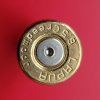hybridspecies
Active Member
I'm having some pressure issues with a new Savage Model 12 LRP in 6.5CR. I put 101 handloaded rounds through it and all of them were flattening primers. A few of the cases even have faint ejector rings. The loads consisted of virgin Lapua LR cases, H4350, Berger 140 Hybrids, and CCI BR2 primers. Powder charges ranged from 40.4 grains to 42.3 grains in 0.1 grain increments. These charges are within the ranges prescribed by both Berger and Sierra for similar bullets, albeit the upper end of the ranges. I had originally suspected that I was seating too close to the lands, but a subsequent firing with a magazine length round produced the same effect.
I'm now wondering if there's something wrong with the chamber as I've heard that Savage had issues with this rifle early in production. I don't own a borescope, but I have a cheap endoscope that I bought on Amazon a couple of years ago so I used it to take some pictures of the chamber the other day. I'm not sure what to look for, so I'm hoping that the smiths and other experts on the site might be able to offer opinions based on what they are seeing. Unfortunately the images lack detail (the difference between a $60 endoscope vs a $600 borescope I suppose), but please take a look and let me know if anything is grossly out of order.
In some of the photos, it looks to me like there is a protrusion of the neck space into the chamber slightly past the shoulder space, but I have no idea if that's normal on all rifles or what to look for. I also took a video of the inside of the chamber that for some reason shows a lot more detail than the photos, but I'm not sure if forum rules allow me to post a link to that video (its hosted on youtube).
Here are some of the stills of the inside of the chamber (the white specs are lint from the cleaning patches):





I'm now wondering if there's something wrong with the chamber as I've heard that Savage had issues with this rifle early in production. I don't own a borescope, but I have a cheap endoscope that I bought on Amazon a couple of years ago so I used it to take some pictures of the chamber the other day. I'm not sure what to look for, so I'm hoping that the smiths and other experts on the site might be able to offer opinions based on what they are seeing. Unfortunately the images lack detail (the difference between a $60 endoscope vs a $600 borescope I suppose), but please take a look and let me know if anything is grossly out of order.
In some of the photos, it looks to me like there is a protrusion of the neck space into the chamber slightly past the shoulder space, but I have no idea if that's normal on all rifles or what to look for. I also took a video of the inside of the chamber that for some reason shows a lot more detail than the photos, but I'm not sure if forum rules allow me to post a link to that video (its hosted on youtube).
Here are some of the stills of the inside of the chamber (the white specs are lint from the cleaning patches):

